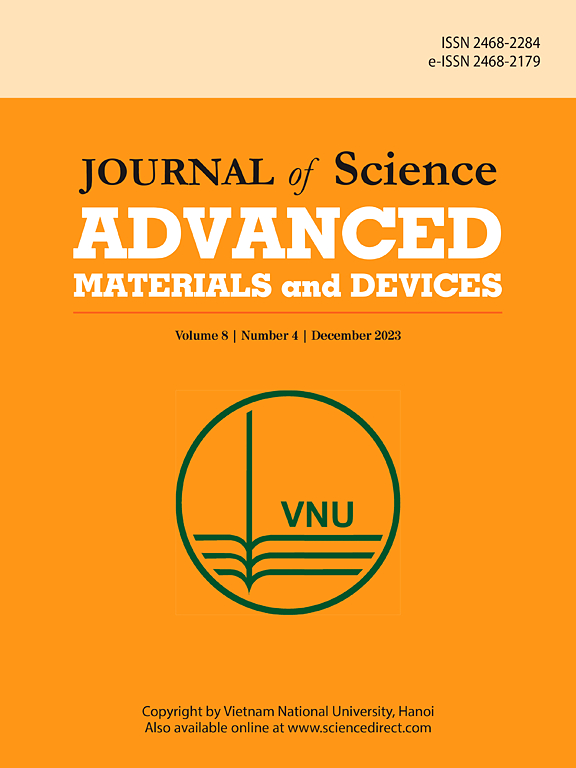P(VDF-TrFE)纳米纤维的电晕三极管极化:机制和优化策略
IF 6.7
3区 材料科学
Q1 MATERIALS SCIENCE, MULTIDISCIPLINARY
Journal of Science: Advanced Materials and Devices
Pub Date : 2025-02-25
DOI:10.1016/j.jsamd.2025.100870
引用次数: 0
摘要
聚偏氟乙烯-三氟乙烯(P(VDF-TrFE))纳米纤维极化工艺的有效性对于其在工程应用(即人工压电蒙皮、自传感复合材料)中的应用至关重要。传统的接触极化方法通过高孔纳米纤维膜存在电击穿风险,而电晕极化技术提供了一种非接触替代方案,利用离子产生极化压电材料,而无需高压电极和样品之间的直接相互作用。对于P(VDF-TrFE)薄膜,电晕极化过程已经建立,但是对于P(VDF-TrFE)纳米纤维,文献中缺乏可靠的方法。本研究通过系统地研究P(VDF-TrFE)薄膜和纳米纤维的电晕极化之间的差异来解决这一空白,旨在揭示所涉及的不同物理机制。首先,对P(VDF-TrFE)薄膜的电晕三极管设置进行了优化,实现了23 pC N−1的压电应变系数d33。然后系统地重新校准电晕设置的参数,以适应纳米纤维的极化,并通过实验研究讨论和验证这些调整背后的基本原理。这种精细的电晕极化方法导致纳米纤维的d33等于−20.8 pC N−1,当代允许全面理解两种不同方法背后的物理机制。本文章由计算机程序翻译,如有差异,请以英文原文为准。
Corona triode poling of P(VDF-TrFE) nanofibers: Mechanisms and optimization strategies
The effectiveness of the poling process of poly(vinylidene fluoride-trifluoroethylene) (P(VDF-TrFE)) nanofibers is essential for their use in engineering applications (i.e., artificial piezoelectric skins, self-sensing composite materials). While traditional contact poling methods present electrical breakdown risks through the highly porous nanofibrous membranes, the corona poling technique offers a non-contact alternative, utilizing ion generation to polarize piezoelectric materials without direct interaction between the high-voltage electrode and the sample. The corona poling process is well-established for P(VDF-TrFE) thin films, but literature lacks a reliable methodology for P(VDF-TrFE) nanofibers. This study addresses this gap by systematically investigating the differences between the corona poling of P(VDF-TrFE) films and nanofibers and aims to disclose the distinct physical mechanisms involved. First, the corona triode setup is optimized for P(VDF-TrFE) films, achieving a piezoelectric strain coefficient of 23 pC N−1. The parameters of the corona setup are then methodically recalibrated for the nanofiber's polarization, with the rationale behind these adjustments discussed and validated through experimental investigations. Such a refined corona poling method leads to a equal to −20.8 pC N−1 for the nanofibers, contemporary allowing for a comprehensive understanding of the physical mechanisms behind the two distinct methods.
求助全文
通过发布文献求助,成功后即可免费获取论文全文。
去求助
来源期刊

Journal of Science: Advanced Materials and Devices
Materials Science-Electronic, Optical and Magnetic Materials
CiteScore
11.90
自引率
2.50%
发文量
88
审稿时长
47 days
期刊介绍:
In 1985, the Journal of Science was founded as a platform for publishing national and international research papers across various disciplines, including natural sciences, technology, social sciences, and humanities. Over the years, the journal has experienced remarkable growth in terms of quality, size, and scope. Today, it encompasses a diverse range of publications dedicated to academic research.
Considering the rapid expansion of materials science, we are pleased to introduce the Journal of Science: Advanced Materials and Devices. This new addition to our journal series offers researchers an exciting opportunity to publish their work on all aspects of materials science and technology within the esteemed Journal of Science.
With this development, we aim to revolutionize the way research in materials science is expressed and organized, further strengthening our commitment to promoting outstanding research across various scientific and technological fields.
 求助内容:
求助内容: 应助结果提醒方式:
应助结果提醒方式:


